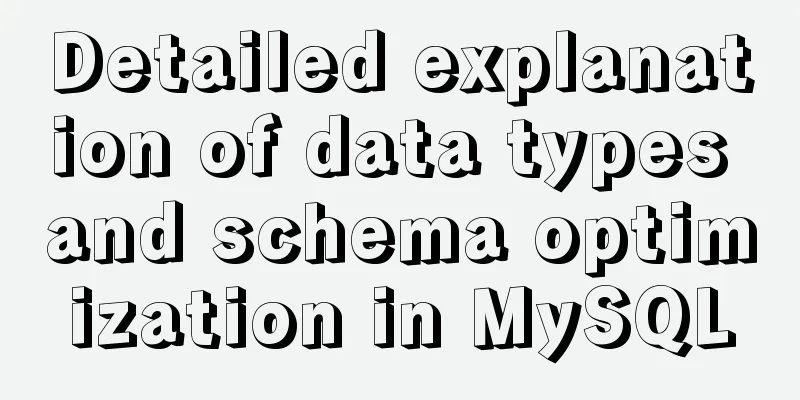Detailed explanation of data types and schema optimization in MySQL

|
I'm currently learning about MySQL optimization. This article introduces the optimization of data types and schema.
1. Choose the optimized data type MySQL supports many data types, and how to choose the correct data type is crucial to performance. The following principles can help determine the data type:
Whenever possible, use the smallest data type that can correctly store the data. This will use less disk, memory, and cache, and will take less time to process.
When two data types are capable of storing the same field, choosing the simpler one is often the best option. For example, integers and strings. Since the operation cost of integers is lower than that of characters, when choosing between the two, choosing integers usually gives better performance.
When a column can be NULL, MySQL needs to do more work in terms of indexing and value comparison. Although the impact on performance is not significant, you should try to avoid designing it to be NULL. In addition to the above principles, the steps to follow when choosing a data type are: first determine the appropriate large type, such as data, string, time, etc.; then select the specific type. We will now discuss some specific types under the larger category, starting with numbers, which come in two types: integers and real numbers. 1.1 Integer Types The integer types and the space they occupy are as follows:
The storage range of an integer type is related to the size of the space: -2^(N-1) to 2^(N-1)-1, where N is the number of bits in the space. The integer type has the optional attribute UNSIGNED. When declared, it means that negative numbers are not allowed. The storage range becomes: 0 to 2^(N)-1, which is doubled. In MySQL, you can also specify the width for integer types, such as INT(1), but this is not very meaningful and does not limit the legal range of values. Values from -2^31 to 2^31-1 can still be stored. What is affected is the number of characters displayed by the interactive tools that interact with MySQL. 1.2 Real number types The comparison of real number types is as follows:
As can be seen from the above, FLOAT and DOUBLE both have fixed space sizes, but at the same time, because they use standard floating-point operations, they can only be calculated approximately. DECIMAL can achieve precise calculations, but it takes up more space and consumes more computing overhead. The space occupied by DECIMAL is related to the specified precision, for example, DECIMAL(M,D):
When storing DECIMAL data, MySQL stores it as a binary string, storing 9 digits for every 4 bytes. When the number is less than 9 digits, the space occupied by the number is as follows:
The digits before and after the decimal point will be stored separately, and the decimal point also occupies 1 byte. Here are two calculation examples:
It can be seen that DECIMAL still takes up a lot of space, so DECIMAL is only needed when precise calculations of decimals are required. In addition, we can also use BIGINT instead of DECIMAL. For example, if you need to ensure calculations with 5 decimal places, you can multiply the value by 10 to the fifth power and store it as BIGINT. This can avoid the problems of inaccurate floating-point storage calculations and the high cost of precise DECIMAL calculations. 1.3 String Type The most commonly used string types are VARCHAR and CHAR. As a variable-length string, VARCHAR uses 1 or 2 extra bytes to record the length of the string. When the maximum length does not exceed 255, only 1 byte is needed to record the length. If it exceeds 255, 2 bytes are required. VARCHAR is suitable for:
CHAR is a fixed-length string. Sufficient space is allocated according to the defined string length. Applicable scenarios:
In addition to VARCHAR and CHAR, BLOB and TEXT types can be used to store large strings. The difference between BLOB and TEXT is that BLOB is stored in binary format, while TEXT is stored in character format. This also means that BLOB type data has no concept of character set and cannot be sorted by character, while TEXT type data has the concept of character set and can be sorted by character. The usage scenarios of the two are also determined by the storage format. When storing binary data, such as pictures, BLOB should be used, and when storing text, such as articles, the TEXT type should be used. 1.4 Date and Time Types The minimum time granularity that can be stored in MySQL is seconds. Common date types include DATETIME and TIMESTAMP.
The value displayed by TIMESTAMP will depend on the time zone, which means that the value queried in different time zones will be different. In addition to the differences listed above, TIMESTAMP has a special property. When inserting and updating, if the value of the first TIMESTAMP column is not specified, the value of this column will be set to the current time. During the development process, we should try to use TIMESTAMP, mainly because it only takes half the space of DATETIME and is more space efficient. What if we want to store the date and time accurately to the second? Since MySQL does not provide it, we can use BIGINT to store timestamps at the microsecond level, or use DOUBLE to store the fractional part after the second. 1.5 Choosing an Identifier Integers are generally the best choice for identifiers, primarily because they are simple, fast to compute, and can use AUTO_INCREMENT. 2. Paradigms and anti-paradigms Simply put, a paradigm is the level of design standards that a data table's structure complies with. In the first normal form, attributes are inseparable. All tables built in current RDBMS systems conform to the first normal form. The second paradigm eliminates partial dependence on non-primary attribute codes (which can be understood as primary keys). The third paradigm eliminates transitive dependencies on non-primary attribute pairs. In a strictly normalized database, each factual data will appear only once, and there will be no data redundancy. This can bring the following benefits:
However, since the data is scattered in various tables, the tables need to be associated when querying. The advantage of the anti-normalization is that there is no need to perform associations and the data is stored redundantly. In actual applications, there will not be complete normalization or complete denormalization. It is often necessary to mix normalization and denormalization. Using a partially normalized schema is often the best choice. Regarding database design, I saw this passage on the Internet and you can feel it. Database design should be divided into three realms: The first level: just getting started with database design, the importance of paradigms is not yet fully understood. The anti-paradigm design that appears at this time usually causes problems. The second level: As you encounter and solve problems, you will gradually understand the true benefits of the paradigm, and thus be able to quickly design a low-redundancy, high-efficiency database. The third level: After N years of training, you will definitely discover the limitations of the paradigm. At this time, we can break the paradigm and design a more reasonable anti-paradigm part. Paradigms are like the moves in martial arts. If a beginner does not follow the moves, he will only die miserably. After all, the moves are the essence summarized and summarized by masters. As your martial arts skills improve and you become proficient in the moves, you will inevitably discover the limitations of the moves and either forget them or create your own moves. As long as you work hard and persevere for a few more years, you will always reach the second level, and you will always feel that the paradigm is a classic. At this time, those who can not rely too much on the paradigm and quickly break through the limitations of the paradigm are naturally masters. 3. Cache tables and summary tables In addition to the anti-normalization mentioned above, storing redundant data in the table, we can also create a completely independent summary table or cache table to meet the retrieval needs. A cache table refers to a table that stores data that can be obtained from other tables in the schema, that is, logically redundant data. A summary table refers to a table that stores non-redundant data calculated by aggregating data using statements such as GROUP BY. Cache tables can be used to optimize search and retrieval query statements. A technique that can be used here is to use different storage engines for cache tables. For example, the main table uses InnoDB, while the cache table can use MyISAM to obtain a smaller index space. You can even put the cache table into a dedicated search system, such as Lucene. Summary tables are designed to avoid the high cost of real-time statistical calculations. The cost comes from two aspects: one is the need to scan most of the data in the table, and the other is to create specific indexes that will affect UPDATE operations. For example, to query the number of WeChat friends in the past 24 hours, you can scan the entire table every hour, write a record to the summary table after statistics, and when querying, you only need to query the latest 24 records in the summary table, without having to scan the entire table for statistics every time you query. When using cache tables and summary tables, you must decide whether to maintain the data in real time or rebuild it periodically, depending on your needs. Compared with real-time maintenance, regular reconstruction can save more resources and reduce table fragmentation. During reconstruction, we still need to ensure that the data is available during operation, which needs to be achieved through "shadow tables". Create a shadow table behind the real table. After filling the data, switch the shadow table and the original table through an atomic rename operation. 4. Speed up ALTER TABLE operations When MySQL performs an ALTER TABLE operation, it often creates a new table, retrieves data from the old table and inserts it into the new table, and then deletes the old table. If the table is large, this will take a long time and cause MySQL service interruption. To avoid service interruptions, two techniques are usually used: Execute the ALTER TABLE operation on a machine that is not providing services, and then switch to the primary database that is providing services; refer to High Performance MySQL MySQL DECIMAL data type The above is a detailed explanation of data types and schema optimization in MySQL. For more information about MySQL data types and schema optimization, please pay attention to other related articles on 123WORDPRESS.COM! You may also be interested in:
|
<<: CentOS IP connection network implementation process diagram
>>: The whole process record of vue3 recursive component encapsulation
Recommend
Solution to Apache cross-domain resource access error
In many cases, large and medium-sized websites wi...
Server concurrency estimation formula and calculation method
Recently, I need to stress test the server again....
Vue data two-way binding implementation method
Table of contents 1. Introduction 2. Code Impleme...
A brief discussion on the differences and summary of the three floating point types of float, double and decimal in MySQL
The storage size and range of each floating point...
Mysql some complex sql statements (query and delete duplicate rows)
1. Find duplicate rows SELECT * FROM blog_user_re...
MySQL password contains special characters & operation of logging in from command line
On the server, in order to quickly log in to the ...
How to build pptpd service in Alibaba Cloud Ubuntu 16.04
1. To build a PPTP VPN, you need to open port 172...
Implementation steps for installing Redis container in Docker
Table of contents Install Redis on Docker 1. Find...
Complete the search function in the html page
Recently I've been working on a framework tha...
How to add a disk in Vmware: Expand the disk
This article describes how to add or expand a dis...
Let the web page redirect to other pages after opening for a few seconds
Just add the following code to achieve it. Method ...
How to install MySQL 8.0.17 and configure remote access
1. Preparation before installation Check the data...
js implements clock component based on canvas
Canvas has always been an indispensable tag eleme...
Solution to the problem that Java cannot connect to MySQL 8.0
This article shares a collection of Java problems...
Complete list of CentOS7 firewall operation commands
Table of contents Install: 1. Basic use of firewa...










